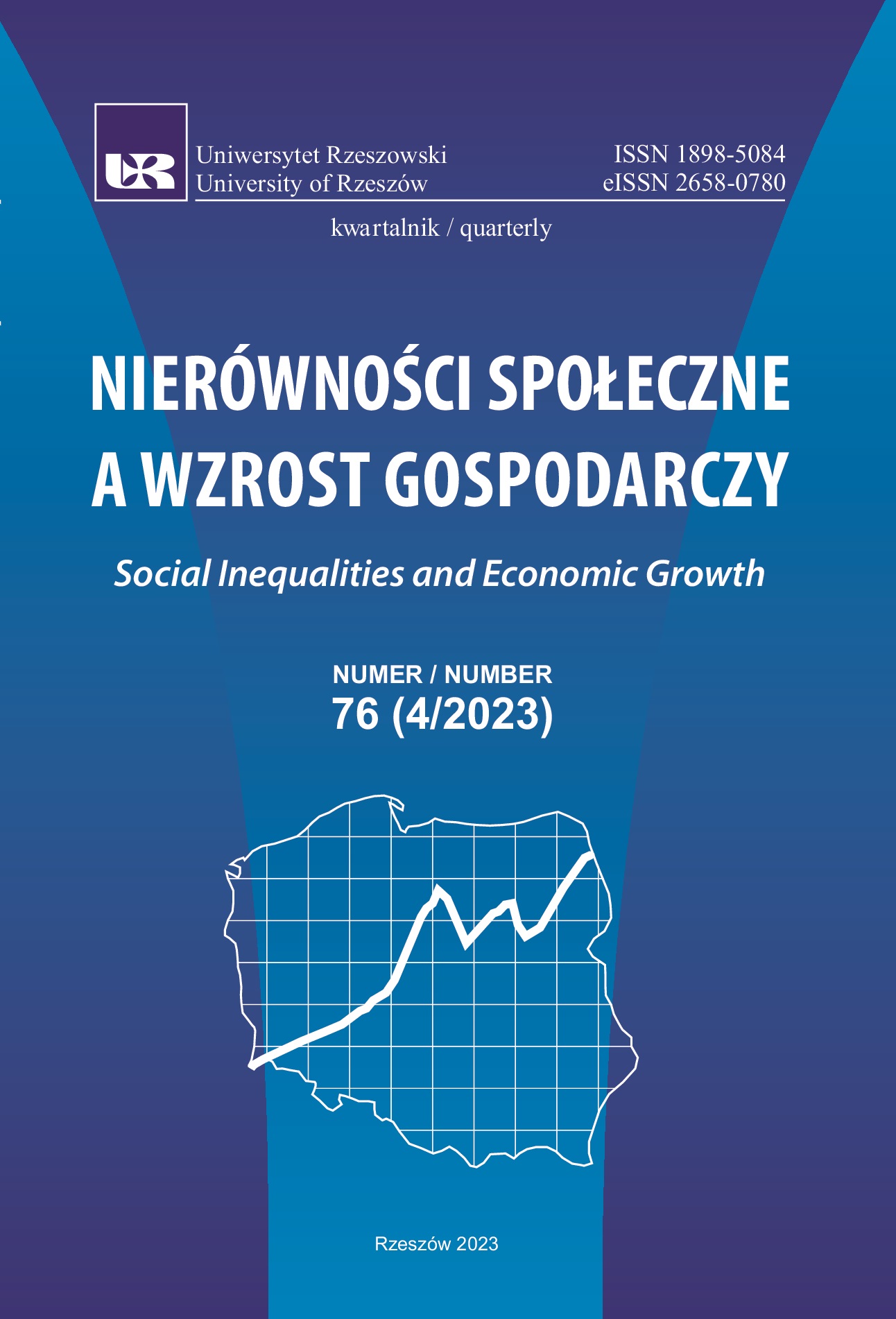Transformacja i reformy gospodarcze w Wietnamie w latach 80. XX wieku. Przyczyny, przebieg i skutki
DOI:
https://doi.org/10.15584/nsawg.2023.4.6Słowa kluczowe:
Wietnam, reformy gospodarcze, transformacja gospodarczaAbstrakt
Zainicjowany ponad trzy dekady temu proces transformacji krajów socjalistycznych miał charakter bezprecedensowy i złożony. Opis i analiza dróg przejścia od „czystej” gospodarki nakazowo-rozdzielczej do gospodarki rynkowej lub modeli hybrydowych może być nie tylko podstawą refleksji naukowej, ale również stanowić podstawę formułowania zaleceń dla innych reformujących się krajów rozwijających się. Jednym z ciekawszych przykładów jest Wietnam, który doświadczył jednego z najwyższych wskaźników wzrostu gospodarczego i redukcji ubóstwa na świecie, połączonych z osiągnięciem ogólnej stabilizacji makroekonomicznej. W świetle tych wydarzeń zasadne są pytania o to, jak przebiegał proces transformacji w Wietnamie i jak wpłynął on na jego gospodarkę. By odpowiedzieć na te pytania, w pracy wykorzystywana jest przede wszystkim analiza historyczna bazująca na literaturze krajowej i zagranicznej oraz analiza danych zastanych.
W wyniku przeprowadzonych analiz można stwierdzić, że kluczową cechą procesu reform w Wietnamie było to, że wysiłki skupiały się tam, gdzie produkcja mogła szybko reagować, tj. tam, gdzie elastyczność podaży była wysoka, tak aby zapewnić utrzymanie, a najlepiej przyspieszenie wzrostu w okresie przejściowym, sprzyjając wysokim stopom inwestycji i oszczędności. Względnie harmonijne połączenie spontanicznych reform na szczeblu oddolnym i zdecydowanych działań najwyższego kierownictwa politycznego mogłoby zostać zauważone jako jedna z wyjątkowych cech wietnamskich reform i powód wyjaśniający, dlaczego wietnamskie reformy fundamentalnie zmieniły podstawy starego modelu społeczno-ekonomicznego, nie powodując głębokiej recesji.
Downloads
Bibliografia
Beresford, M. (2008). Doi Moi in review: The challenges of building market socialism in Vietnam. Journal of Contemporary Asia, 38(2), 221–243. DOI: 10.1080/00472330701822314.
CIA. (2005). Soviet and Chinese Aid to North Vietnam. Pobrane z: https://www.cia.gov/readingroom/docs/CIA-RDP80B01495R000500050038-4.pdf (2023.06.20).
Cima, R.J. (1989). Vietnam: A country study. Washington, D.C.: Federal Research Division, Library of Congress.
De Vylder, S. (1993). State and Market in Vietnam: Some Issues for an Economy in Transition. Macroeconomic Studies, 38, 1–40.
Hiebert, M. (1990). The tilling fields: Vietnam regains role as major rice exporter. Far Eastern Economic Review, 148, 32–34.
International Monetary Fund Database. Pobrane z: https://www.imf.org/en/Data (2023.06.22).
Irvin, G. (1995). Vietnam: Assessing the achievements of Doi Moi. The Journal of Development Studies, 31(5), 725–750. DOI: 10.1080/00220389508422387.
Khanh, H.K. (1976). Restructuring the economy of South Vietnam. Southeast Asian Affairs, 467–484. DOI: 10.1355/9789812306661-034.
Jurdeczka, M. (2019). Transition Economy of Vietnam: A New Horizon of Opportunities. W: K. Żakowski, B. Kowalski (red.), Power Shifts in East Asia and Their Implications for Asia-Europe Relations. Łódź: Wydawnictwo Uniwersytetu Łódzkiego.
Le, H. (2019). Economic reforms, external liberalization and macroeconomic performance in Vietnam. International Research Journal of Finance and Economics, 176, 129–155. DOI: 10.31219/osf.io/ctj5z.
Man’emon, T., Nagata, I., Jun’ichiro, Sh. (1962). Economic Development of South Viet Nam – Slow but Steady Progress of Vietnamese Economy. The Institute of Asian Economic Affairs. Pobrane z: https://www.ide.go.jp/library/English/Publish/Periodicals/De/pdf/62_02_08.pdf (2023.06.20).
Nguyen, T.T.T. (2009). Doi moi – zmiany społeczno-ekonomiczne w Wietnamie: ich źródła, istota i rezultaty. Azja-Pacyfik, XII, 71–99.
Phuong, T., Ta, G. (1978). The postwar economic planning and development of Vietnam. Southeast Asian Affairs 1978, 305–311. DOI: 10.1355/9789812306685-027.
Starzyk, K. (1991). Zagraniczne inwestycje bezpośrednie w gospodarkach Azji Pacyfiku. Warszawa: Wydawnictwo Naukowe Semper.
Vasavakul, T. (1999). Vietnam: sectors, classes, and the transformation of a Leninist state. W: J.W. Morley (red.), Driven by Growth: Political Change in the Asia-Pacific Region (revised edition) (s. 58–82). New York: Routledge.
Vuong, Q.H. (2004). The Vietnam’s transition economy and its fledgling financial markets: 1986–2003. Pobrane z: https://papers.ssrn.com/sol3/Delivery.cfm/SSRN_ID1475530_code328184.pdf?abstractid=1475530&mirid=1 (2023.06.22).
Vuong, Q.H. (2014). Vietnam’s political economy: a discussion on the 1986–2016 period. Working Papers CEB 14-010, ULB – Universite Libre de Bruxelles. Pobrane z: https://dipot.ulb.ac.be/dspace/bitstream/2013/163371/1/wp14010.pdf (2023.06.22).
World Bank (1990). Vietnam: Stabilization and Structural Reforms: an Economic Report, Report No. 8249-VN.
World Bank (1993). Vietnam Transition to the Market an Economic Report, Report No. 11902-VN.
World Bank Database. Pobrane z: https://data.worldbank.org/ (2023.06.22).
World Inequality Database. Pobrane z: https://wid.world/data/ (2023.06.22).
Pobrania
Opublikowane
Jak cytować
Numer
Dział
Licencja
Prawa autorskie (c) 2023 Uniwersytet Rzeszowski

Utwór dostępny jest na licencji Creative Commons Uznanie autorstwa – Na tych samych warunkach 4.0 Miedzynarodowe.


